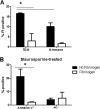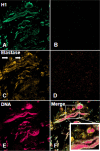Fibrinogen regulates the cytotoxicity of mycobacterial trehalose dimycolate but is not required for cell recruitment, cytokine response, or control of mycobacterial infection
- PMID: 20028811
- PMCID: PMC2825938
- DOI: 10.1128/IAI.00451-09
Fibrinogen regulates the cytotoxicity of mycobacterial trehalose dimycolate but is not required for cell recruitment, cytokine response, or control of mycobacterial infection
Abstract
During inflammatory responses and wound healing, the conversion of soluble fibrinogen to fibrin, an insoluble extracellular matrix, long has been assumed to create a scaffold for the migration of leukocytes and fibroblasts. Previous studies concluded that fibrinogen is a necessary cofactor for mycobacterial trehalose 6,6'-dimycolate-induced responses, because trehalose dimycolate-coated beads, to which fibrinogen was adsorbed, were more inflammatory than those to which other plasma proteins were adsorbed. Herein, we investigate roles for fibrin(ogen) in an in vivo model of mycobacterial granuloma formation and in infection with Mycobacterium tuberculosis, the causative agent of tuberculosis. In wild-type mice, the subcutaneous injection of trehalose dimycolate-coated polystyrene microspheres, suspended within Matrigel, elicited a pyogranulomatous response during the course of 12 days. In fibrinogen-deficient mice, neutrophils were recruited but a more suppurative lesion developed, with the marked degradation and disintegration of the matrix. Compared to that in wild-type mice, the early formation of granulation tissue in fibrinogen-deficient mice was edematous, hypocellular, and disorganized. These deficiencies were complemented by the addition of exogenous fibrinogen. The absence of fibrinogen had no effect on cell recruitment or cytokine production in response to trehalose dimycolate, nor was there a difference in lung histopathology or overall bacterial burden in mice infected with Mycobacterium tuberculosis. In this model, fibrin(ogen) was not required for cell recruitment, cytokine response, or response to infection, but it promoted granulation tissue formation and suppressed leukocyte necrosis.
Figures





Similar articles
-
In vivo activity of released cell wall lipids of Mycobacterium bovis bacillus Calmette-Guérin is due principally to trehalose mycolates.J Immunol. 2005 Apr 15;174(8):5007-15. doi: 10.4049/jimmunol.174.8.5007. J Immunol. 2005. PMID: 15814731
-
A role for tumour necrosis factor-alpha, complement C5 and interleukin-6 in the initiation and development of the mycobacterial cord factor trehalose 6,6'-dimycolate induced granulomatous response.Microbiology (Reading). 2008 Jun;154(Pt 6):1813-1824. doi: 10.1099/mic.0.2008/016923-0. Microbiology (Reading). 2008. PMID: 18524936 Free PMC article.
-
CD3+ cells transfer the hypersensitive granulomatous response to mycobacterial glycolipid trehalose 6,6'-dimycolate in mice.Microbiology (Reading). 2006 Dec;152(Pt 12):3765-3775. doi: 10.1099/mic.0.29290-0. Microbiology (Reading). 2006. PMID: 17159227
-
Immunological properties of trehalose dimycolate (cord factor) and other mycolic acid-containing glycolipids--a review.Microbiol Immunol. 2001;45(12):801-11. doi: 10.1111/j.1348-0421.2001.tb01319.x. Microbiol Immunol. 2001. PMID: 11838897 Review.
-
[Up-to-date understanding of tuberculosis immunity].Kekkaku. 2003 Jan;78(1):51-5. Kekkaku. 2003. PMID: 12683337 Review. Japanese.
Cited by
-
Matrix metalloproteinase inhibitors enhance the efficacy of frontline drugs against Mycobacterium tuberculosis.PLoS Pathog. 2018 Apr 26;14(4):e1006974. doi: 10.1371/journal.ppat.1006974. eCollection 2018 Apr. PLoS Pathog. 2018. PMID: 29698476 Free PMC article.
-
Hypercoagulability in Tuberculosis: Pathophysiological Mechanisms, Associated Risks, and Advances in Management-A Narrative Review.J Clin Med. 2025 Jan 24;14(3):762. doi: 10.3390/jcm14030762. J Clin Med. 2025. PMID: 39941433 Free PMC article. Review.
-
Neutrophils Promote Mycobacterial Trehalose Dimycolate-Induced Lung Inflammation via the Mincle Pathway.PLoS Pathog. 2012;8(4):e1002614. doi: 10.1371/journal.ppat.1002614. Epub 2012 Apr 5. PLoS Pathog. 2012. PMID: 22496642 Free PMC article.
-
Mycobacterium tuberculosis infection and tissue factor expression in macrophages.PLoS One. 2012;7(9):e45700. doi: 10.1371/journal.pone.0045700. Epub 2012 Sep 24. PLoS One. 2012. PMID: 23029190 Free PMC article.
-
Mycobacterium tuberculosis exploits human interferon γ to stimulate macrophage extracellular trap formation and necrosis.J Infect Dis. 2013 Jul;208(1):109-19. doi: 10.1093/infdis/jit097. Epub 2013 Mar 8. J Infect Dis. 2013. PMID: 23475311 Free PMC article.
References
-
- Altieri, D. C., J. H. Morrissey, and T. S. Edgington. 1988. Adhesive receptor Mac-1 coordinates the activation of factor X on stimulated cells of monocytic and myeloid differentiation: an alternative initiation of the coagulation protease cascade. Proc. Natl. Acad. Sci. USA 85:7462-7466. - PMC - PubMed
-
- Axelrod, S., H. Oschkinat, J. Enders, B. Schlegel, V. Brinkmann, S. H. Kaufmann, A. Haas, and U. E. Schaible. 2008. Delay of phagosome maturation by a mycobacterial lipid is reversed by nitric oxide. Cell. Microbiol. 10:1530-1545. - PubMed
-
- Bach, T. L., C. Barsigian, D. G. Chalupowicz, D. Busler, C. H. Yaen, D. S. Grant, and J. Martinez. 1998. VE-cadherin mediates endothelial cell capillary tube formation in fibrin and collagen gels. Exp. Cell Res. 238:324-334. - PubMed
-
- Brinkmann, V., U. Reichard, C. Goosmann, B. Fauler, Y. Uhlemann, D. S. Weiss, Y. Weinrauch, and A. Zychlinsky. 2004. Neutrophil extracellular traps kill bacteria. Science 303:1532-1535. - PubMed
Publication types
MeSH terms
Substances
Grants and funding
LinkOut - more resources
Full Text Sources
Medical
Molecular Biology Databases

